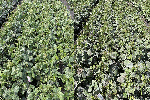When Wayne Pluske, from Equii, and Dr Gaus Azam from WA’s Department of Primary Industries and Regional Development (DPIRD) met Cameron and Sarah Mudge in 2021, the Holt Rock growers were keen to listen.
The researchers had ventured to WA’s eastern grain belt to see what soil amelioration support they could provide and talk about revolutionary amelioration interventions being supported by GRDC.
Cameron and Sarah farm 6000 hectares, 400 kilometres south-east of Perth. Cameron describes his soil types as a 60:20:20 mix of light, medium and heavy soils, where the annual rainfall is 330 millimetres. He says there has been little investment in soil amelioration research in his region. Some growers have conducted their own trials, but with mixed and inconclusive results. The topsoil pH range is five to 7.5 across the property, but low pH at depth is Cameron’s major production constraint.
“We have been liming since 2004, aiming for topsoil readings of six to help combat this,” he says. Application is guided by soil tests, economic assessment and advice from his agronomist, who has worked with the Mudges since 2008.
In 2020, they hired a deep ripper with inclusion plates to ameliorate acidity at depth and remove any hardpan at the same time. This is a system that has been proven in other areas of WA.
“We did 60ha to get a feel for this sort of amelioration, but yield gains didn’t seem to compare to what farmers get in other areas of the state,” Cameron says, adding he experienced seeding issues and realised he needed to deal with shallow ironstone soils before undertaking a ripping program.
In 2021, the business bought a H4 Reefinator to address this. “Ripping will hopefully be much easier once these soil types have been ameliorated, but yield gains still need to be proven.”
Via the GRDC investment, a massive re-engineered site has been created on the Mudges’ property to a depth of nearly one metre, then backfilled with a variety of products to create an optimal soil profile. The aim is to see if any major production gains on this Morrel soil type would be possible, and then work backwards to determine what elements of this intervention were feasible for growers.
It is a bold, ambitious and site-specific endeavour but may well help inform us as to how to address the big challenges.
At this site, gypsum, compost and other soil types were trucked in and layered. The soil profile had to settle in the first year and then was cropped to oats and barley.
Frost and dry starts have hampered data generation, but Cameron says the trucked-in soil with low pH looks like it may have potential in terms of being easiest for growers to replicate if yield gains are made. The Mudges trialled a Pederick ripper this year to mix the top 30 centimetres of soil and improve pH in
deep yellow sand, testing its effectiveness before considering investment in a modern machine.
“We only did 15ha, and we hope to do a little more next year before making the call on a new machine or not.”
The Mudges are watching DPIRD researchers with interest.
More information: GroundCoverTM story – ‘Moonshot’ investment tracks soil amelioration over time and space

























































